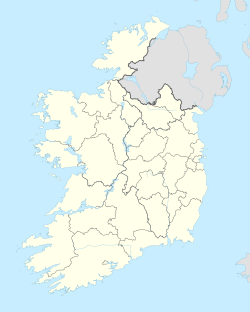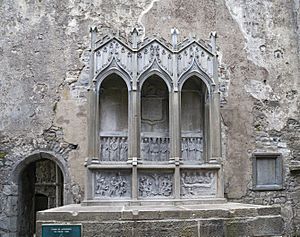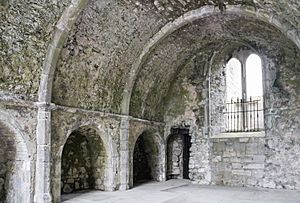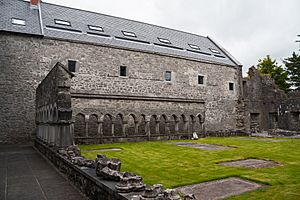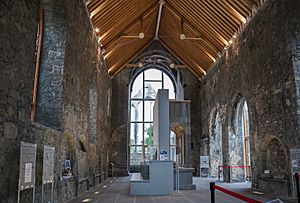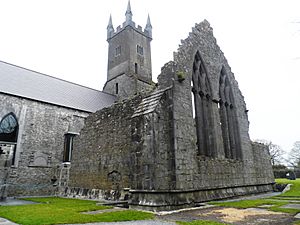Ennis Friary facts for kids
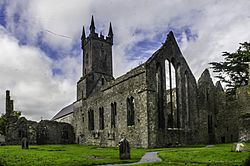 |
|
| Monastery information | |
|---|---|
| Order | Franciscans |
| Established | mid-13th century |
| Disestablished | formally suppressed in 1543 interrupted in practice 1697 new friary still functional |
| People | |
| Founder(s) | Donnchadh Cairprech Ó Briain (Dermot O'Brian) |
| Architecture | |
| Heritage designation | National Monument |
| Site | |
| Location | Abbey Street, Ennis |
| Coordinates | 52°50′46″N 8°58′52″W / 52.846°N 8.981°W |
| Public access | yes |
| Official name | Ennis Friary |
| Reference no. | 170 |
Ennis Friary (in Irish: Mainistir na hInse) is an old Franciscan monastery in Ennis, County Clare, Ireland. It was built in the middle of the 1200s. The powerful O'Brien dynasty helped support it for many years.
Even after monasteries were officially closed in the 1500s, the friary kept going for a while. In the early 1600s, its buildings were given to the Church of Ireland. They used it as a church until the late 1800s. After a new church was built, the old friary became a ruin.
Since the late 1800s, the Office of Public Works has looked after it. In 1969, it was officially given back to the Franciscan Order. Today, the friary is still a ruin, but you can visit it. It is a National Monument of Ireland. The Franciscans now have a new church nearby called the Church of the Immaculate Conception.
Contents
Where is Ennis Friary Located?
The old Ennis Friary is on Abbey Street in Ennis. It is close to the River Fergus.
The Story of Ennis Friary
Who Started Ennis Friary?
Donnchadh Cairprech Ó Briain, also known as Dermot O'Brian, was the son of a High King of Ireland. He became the King of Thomond after a fight with his brother. To make up for his past actions, he decided to build a friary. He chose an island in the River Fergus for it. This island was called Cluain Rámhfhada, meaning "meadow of the long rowing."
After the Normans took over Limerick, Donnchadh became loyal to King John. He moved his main home to Clonroad (Ennis) in 1216. Records say he "offered shelter" to the Franciscan Order in Ennis around 1241 or 1242.
Donnchadh helped pay for three monasteries. He rebuilt a Cistercian abbey and built a Dominican house in Limerick. He also started the Franciscan friary in Ennis. This friary was meant to be the burial place for his family. Donnchadh died in 1244. He was buried in the Dominican house in Limerick. This suggests the Ennis friary was not yet finished when he passed away.
Early Years and Growth
In 1276, King Edward I gave the Kingdom of Thomond to his grandson, Thomas de Clare. But Toirdelbach Ó Briain (Turlough O'Brian) refused to give up his land. In 1277, Turlough became King of Thomond. He fought against de Clare and won in 1287.
In 1287 and again in 1306, Turlough gave gifts to the friary. These gifts included bells, crucifixes, and blue-stained glass. Turlough's sons, Muircheartach Ó Briain and Donnchadh mac Toirdelbach Ó Briain, were both buried at the friary.
The friary mostly relied on gifts from local people. It did not own much land or other resources back then. The first buildings were probably much smaller than the ruins we see today. The friary was also the only place for education in the Ennis area.
In 1314, Maccon Caech MacNamara added a sacristy and a refectory to the friary. He died from the plague in 1347 and was buried there. The friary continued to do well. In 1350, the Pope granted a special blessing to Ennis. In 1375, the friars were allowed to travel to find money. That year, records also mention a "school" at Ennis for the first time.
The Franciscan community grew a lot in the 1400s. In 1400, they added the cloister and transept. In 1475, the tall belfry tower was built. In 1507, the order held an important meeting at Ennis.
Changes During the Reformation
In 1537, King Henry VIII ordered that all monasteries in his kingdom be closed. In 1543, Murrough O'Brien gave up his title as king. He became the first Earl of Thomond. He received lands from other abbeys. Ennis Friary was given to a man named John Neillan.
Murrough died in 1543. This was also the last time the Franciscans held a big meeting at Ennis. Even though it was officially closed, the Franciscans stayed. The O'Briens probably took some of their land. But they also kept supporting the friars. The order could work openly at Ennis until 1570. After that, they had to work in secret.
The Desmond Rebellions caused trouble in the area after 1569. In 1570, Edward Fitton held court hearings, called assizes, right inside Ennis Friary. He had been stopped from doing this a year earlier.
Connor O'Brien, the 3rd Earl of Thomond, died in 1581 and was buried in the friary. His son, Donogh, grew up at the court of Queen Elizabeth I. He did not like the old Irish ways or the Franciscans. When he returned to Clare, he became an Anglican. He worked closely with the English government.
In 1585, Donogh O'Brien became a member of parliament. He supported a fixed tax on land. In 1588, he joined the Council of Connaught. He then received a lot of money from the lands of the former Franciscan houses of Ennis and Quin.
Challenges and Reestablishment
During the Nine Years' War, Donogh O'Brien supported the English crown. In the early 1600s, he asked the Church of Ireland to use Ennis Friary as a church. One Franciscan friar, who had come back from Spain, was caught. But Donogh said he was "insane." This was because the friar was from the Broudin family, who wrote down the history of the O'Briens. This allowed the "insane" friar to say mass in his room at the friary until he died in 1617.
In 1628, the friary was reopened under Charles I of England. But it was closed again in 1651 during the time of the Commonwealth of England. During this period, a scholar named Mícheál Ó Cléirigh visited the friary in 1643. Thaddeus Gorman became the first leader of the friary in 1638. His successor, Eugene O'Cahan, was executed in 1652.
The Franciscans did not hold another big meeting until 1666. After the Penal Laws were passed, Laurence Considine led the friars into exile in 1697. This officially ended the Franciscan presence at Ennis Friary. The building and its land were taken over by John Gore, a former Cromwellian officer.
Religious services at the old friary stopped in 1871. The Church of Ireland built a new church because the old one was too expensive to keep up. The main part of the church, the nave, had a roof until 1887. But by 1893, the whole inside was open to the rain and wind.
Modern Era and Return
In 1892, the Commissioners of Public Works took control of the friary. They did some repairs, but it stayed closed until 1952. The Office of Public Works then did major restoration work.
The Franciscans in Ennis had to hide outside of town for a while in the 1600s and 1700s. But by 1800, they were living as a community again. In 1830, they moved to a new chapel. In 1853, their leader threatened to close the friary if things didn't get better. So, they bought the land for their current site. The first service at their new church, the Church of the Immaculate Conception, was in 1856. A new friary building was finished in 1877. The church was rebuilt in a Gothic Revival style around 1885-1886. Ennis was also a training center for new Franciscans from 1876 to 1902.
The old Ennis Friary was officially given back by the Church of Ireland to the Franciscans in 1969. However, the state still owns and cares for it.
What Can You See at Ennis Friary Today?
The walls of the church, the tall Gothic bell tower, and the transept chapel are still standing. Also, parts of the east side and the cloister remain.
The old friary is open for people to visit. There is a restaurant nearby called The Cloister.
The main part of the church, the nave, now has a roof. It is used to show some of the old stone carvings.
Images for kids


